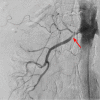Is the Renal Resistive Index a Marker for Revascularization in Atherosclerotic Renal Artery Stenosis?
- PMID: 34094725
- PMCID: PMC8169008
- DOI: 10.7759/cureus.14755
Is the Renal Resistive Index a Marker for Revascularization in Atherosclerotic Renal Artery Stenosis?
Abstract
Renal artery stenosis (RAS) is one of the major causes of resistant/malignant hypertension. It can be described as atherosclerotic or non-atherosclerotic. Atherosclerotic RAS comprises almost 90% of all RAS cases and is a prevalent disease of the elderly. Multiple risk factors contribute to atherosclerosis development, which leads to the release of renin and aldosterone, causing resistant/malignant hypertension. Early recognition is prudent but challenging as there are no early clinical signs. We believe that renal resistive index with supportive clinical, laboratory, and imaging modalities can help select revascularization patients.
Keywords: atherosclerotic renal artery; renal artery stenosis; renal artery stenting; renal resistive index.
Copyright © 2021, Vemireddy et al.
Conflict of interest statement
The authors have declared that no competing interests exist.
Figures





Similar articles
-
Atherosclerotic Renal Artery Stenosis.Curr Treat Options Cardiovasc Med. 2003 Apr;5(2):91-101. doi: 10.1007/s11936-003-0017-9. Curr Treat Options Cardiovasc Med. 2003. PMID: 12686006
-
[Renovascular hypertension: is it only the top of the iceberg?].Pol Merkur Lekarski. 2003 Oct;15(88):371-5; discussion 375-6. Pol Merkur Lekarski. 2003. PMID: 14974369 Polish.
-
Renal artery revascularization improves heart failure control in patients with atherosclerotic renal artery stenosis.Nephrol Dial Transplant. 2010 Mar;25(3):813-20. doi: 10.1093/ndt/gfp393. Epub 2009 Aug 7. Nephrol Dial Transplant. 2010. PMID: 19666661
-
Revascularization in renal artery stenosis.Cardiol Rev. 2012 Jul-Aug;20(4):189-93. doi: 10.1097/CRD.0b013e31824a72e9. Cardiol Rev. 2012. PMID: 22314144 Review.
-
Atherosclerotic Renal Artery Stenosis and Hypertension: Pragmatism, Pitfalls, and Perspectives.Am J Med. 2016 Jun;129(6):635.e5-635.e14. doi: 10.1016/j.amjmed.2015.10.010. Epub 2015 Oct 29. Am J Med. 2016. PMID: 26522797 Review.
References
-
- Bokhari MR, Bokhari SRA. StatPearls [Internet] Treasure Island, FL: StatPearls Publishing; 2020. Renal Artery Stenosis.
-
- Atherosclerotic renovascular disease in United States patients aged 67 years or older: risk factors, revascularization, and prognosis. Kalra PA, Guo H, Kausz AT, et al. Kidney Int. 2005;68:293–301. - PubMed
-
- Atherosclerotic renal artery stenosis: association with emerging vascular risk factors. Paraskevas KI, Hamilton G, Cross JM, Mikhailidis DP. Nephron Clin Pract. 2008;108:0–66. - PubMed
Publication types
LinkOut - more resources
Full Text Sources
